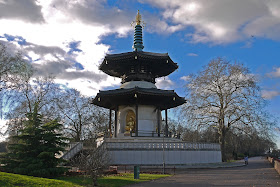Albert Bridge: The start of the walk
We met our friends Dave and Chris to do this walk from Albert Bridge to Tower Bridge, which they had previously twice done for charity. The Thames Path follows the North Bank and there is a helpful description of that route on Walk London website.
We started by crossing the elegant, recently restored Albert Bridge (1873) - the only bridge on the route that I had never seen before. A helpful sign says that "All soldiers must break step when marching across this bridge". It is directed at soldiers from nearby Chelsea Barracks and reflects the bridge's tendency to vibrate under heavy traffic.
We turned left into Battersea Park and followed the riverside to soon reach the Peace Pagoda.
It was opened in 1985 and the permission to build it was the last legislative act of the Greater London Council. According to Wikipedia, there are Peace Pagodoas in many palces across the world, designed to provide a focus for people of all races and creeds, and to help unite them in their search for world peace. Most were been built under the guidance of Nichidatsu Fujii, a Japanese Buddhist monk.
Next up is Chelsea Bridge. It dates only from 1937, replacing a Victorian bridge which had become unsound.
We crossed over here and followed the north bank to Vauxhall Bridge, which looked very colourful in the bright sunshine. It dates from 1907 and also replaced an earlier one, which in turn had replaced a ferry.
On the bridge several vehicles had been stopped as part of some sort of police operation. In the background is the distinctive shape of of the MI6 building. Our conversation turned briefly to Bond movies.
Back now on the south bank, we headed towards Lambeth Bridge (1932), with the Houses of Parliament in the background and London Eye to the right. The red colour scheme is said to reflect its proximity to the House of Lords (whose seats are of course red). Westminster Bridge, being nearer to the green seated House of Commons favours a green trim.
As we approached the bridge I pointed out an interesting piece of art deco decoration on the former London Fire Brigade Headquarters of 1937 (by London County Council architects E P Wheeler and G Weald). It is overall a rather utilitarian building - Pevsner dismisses it as "symmetrical and of no consequence" - but is lifted by the wonderful decoration above the main entrance. A close look reveals galleys, mermaids and chariots among the bas relief and mosaic images.
With just a glance a Lambeth Palace, we crossed Lambeth Bridge and turned right in to Victoria Tower Gardens to be immediately confronted by the Buxton Memorial Fountain (the tower is behind on the left). It commemorates the emancipation of slaves in the British Empire in 1834 and was designed by the architect S S Toulon. It was moved to its current location in 1957.
We then passed a succession of wonders to arrive at Westminster Bridge: Rodin's Burghers of Calais, Westminster Abbey, the rest of the Palace of Westminster. This was easily the most crowded bridge, with frantic photography going on in all directions. I looked up river towards the Golden Jubilee foot bridges and the imposing London Eye.
We followed the south bank now under the former County Hall, past the Eye, a through a Christmas market to break for a quick snack at the British Film Institute. We were not tempted by the matinee performance of Lawrence of Arabia (a strange choice - maybe for the Christmas shoppers?) and headed on under Waterloo Bridge - surely the dullest of all the bridges (Pevsner however praises the elegant shallow curves of its arches).
The next stop is Blackfriars Bridge (1869), with the curious sight of the pillars of the now-demolished Blackfriars Railway Bridge standing beside it in perfect alignment. The capitals of the railway bridge have very attractive designs. The replacement railway bridge is beside the pillars and the construction work which can be seen is connected with Crossrail: the station is being extended across the river.
As you reach the north bank again the French gothic structure that greets you is the second home of the City of London School, built in 1884. The school was relocated to Queen Victoria Street, to the east, in 1986. This run of buildings does not look at all English - for a moment you could easily be in Belgium or northern France.
Soon we came in sight of the Millennium Bridge, with the Shard dominating the skyline behind it.
Before long we were on climbing the steps to join the bridge and enjoyed a great view of St Paul's.
Once across the Millennium Bridge, we followed the south bank, and had a dramatic view of the Tower ahead of us, in sunlight but silhouetted against the darkening sky. I zoomed in with alacrity, lest conditions should change.
We then studied the Italianate old Billingsgate Fish Market (1877), rather dwarfed by the Gherkin and other city buildings behind.
It put us in mind of the Fish Market in Venice, near the Rialto. However, a picture reveals that this was a bit fanciful. Just the arches, I suppose.
We continued to entranced by views of the sunlit Tower as we approached the end of the walk at Tower Bridge, which also looked very striking in the evening sun, with the dark clouds behind.
There was just one last building to record: the striking City Hall, by Richard Rogers. I haven't managed to identify the stone egg.
Distance: 6 miles.
Conditions: cold, but sunny.
Rating: four and half stars. Full of interest and producing a great feeling of achievement. Well done to Dave and Chris for introducing us to it. Expect further London walks!

















No comments:
Post a Comment